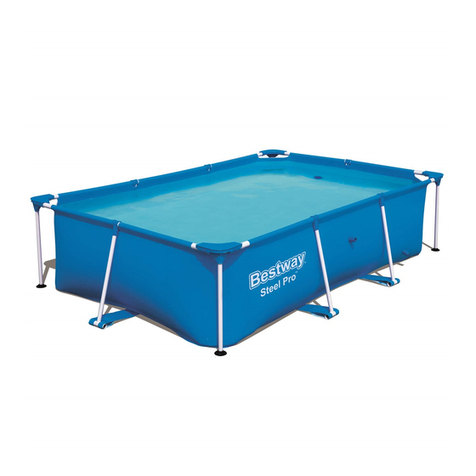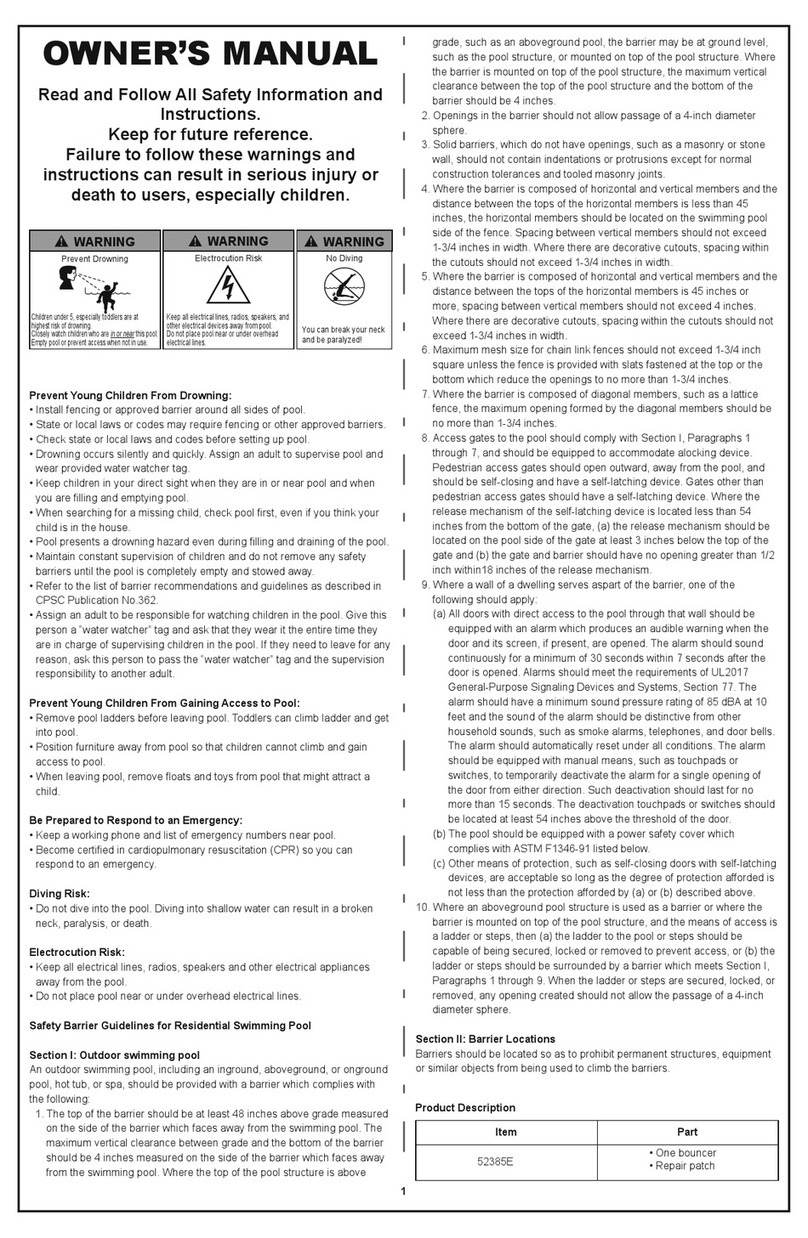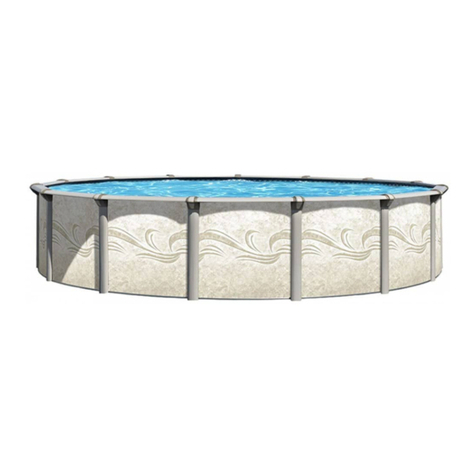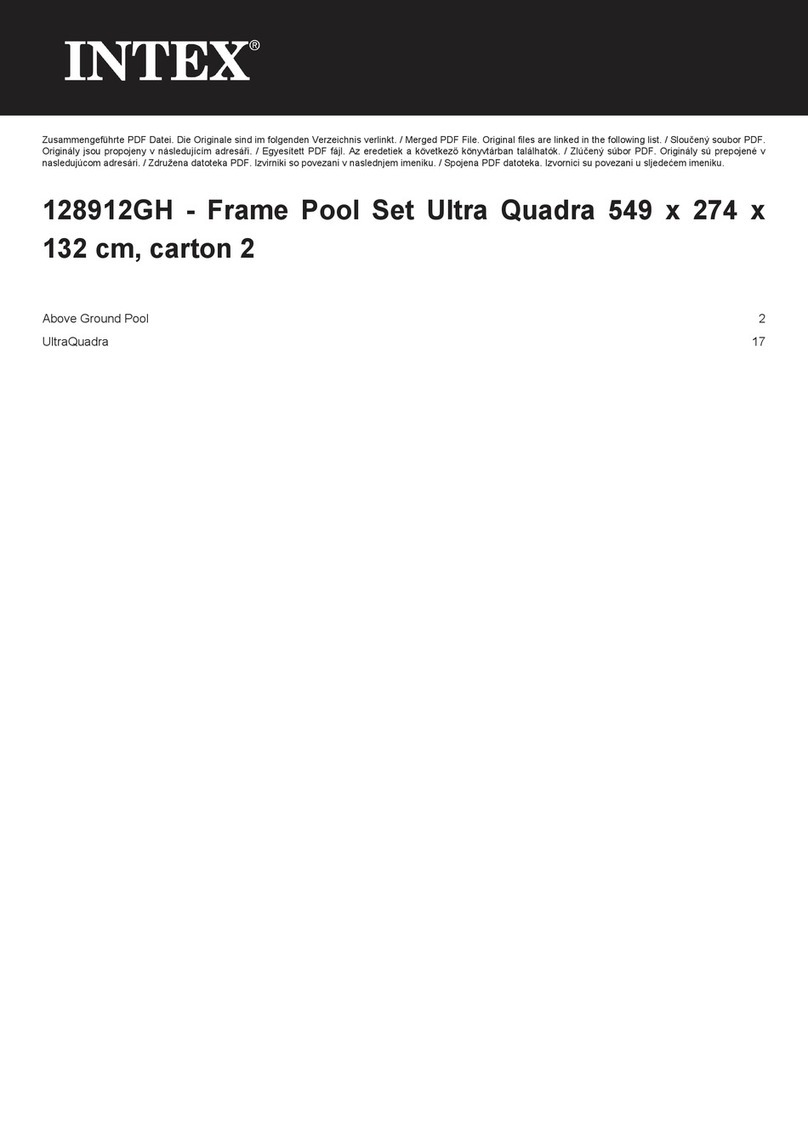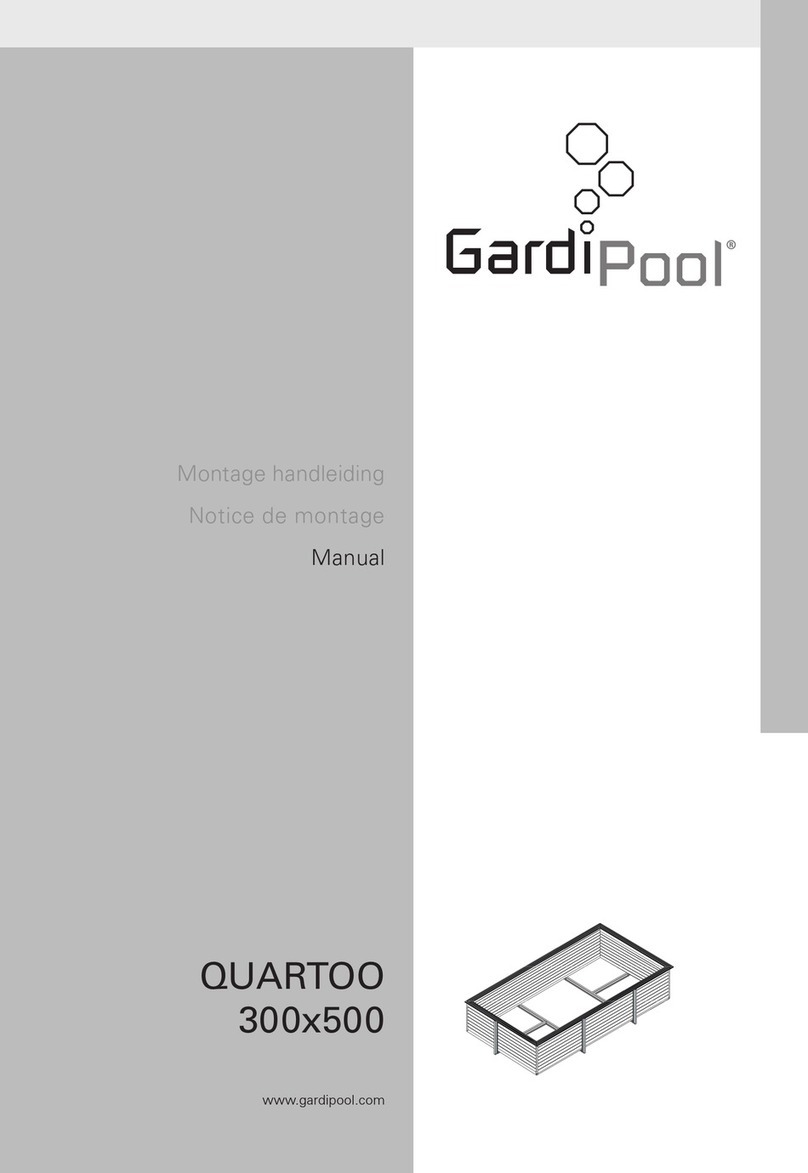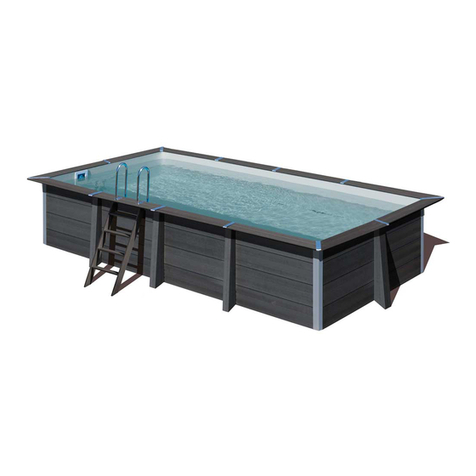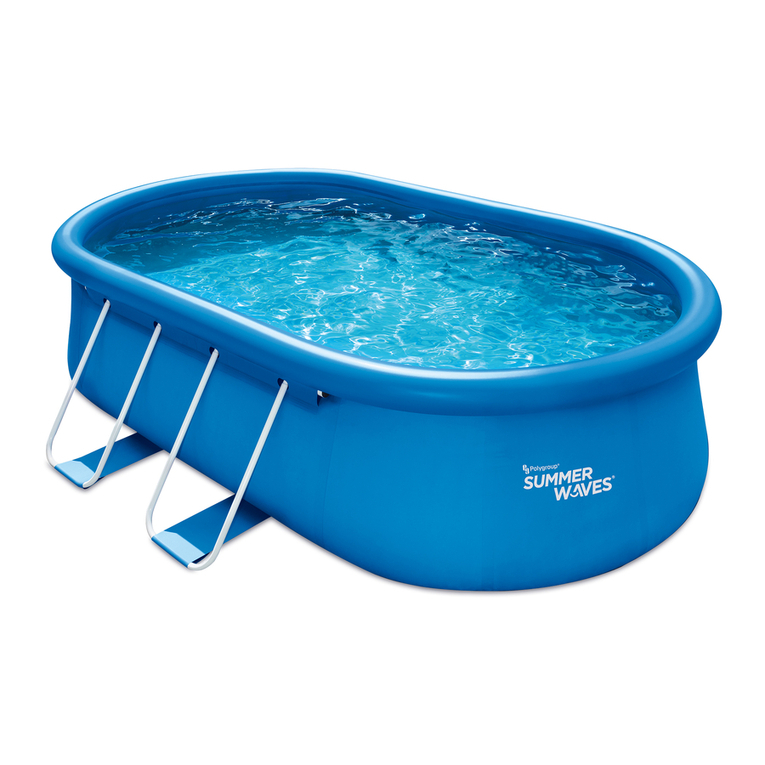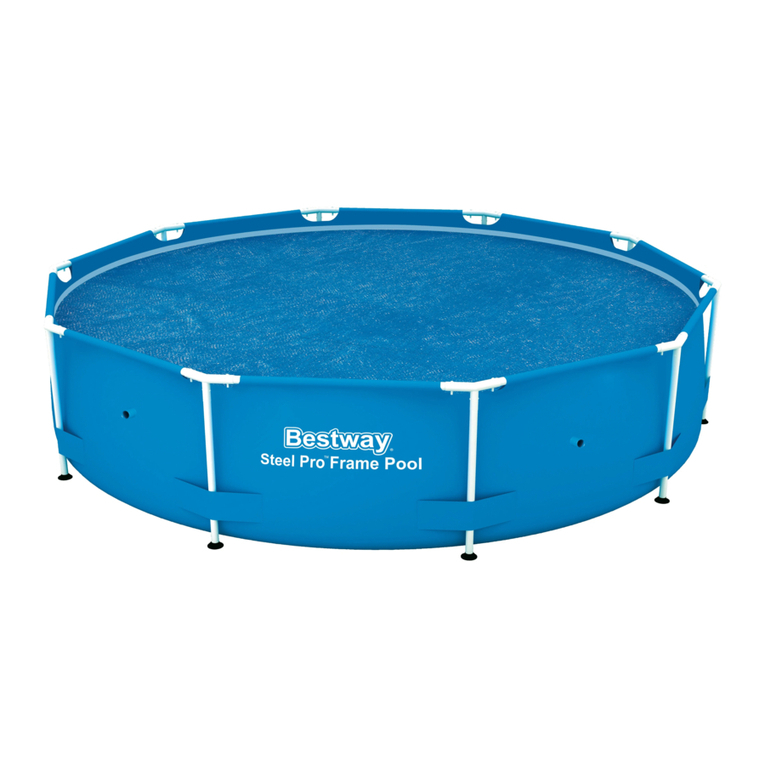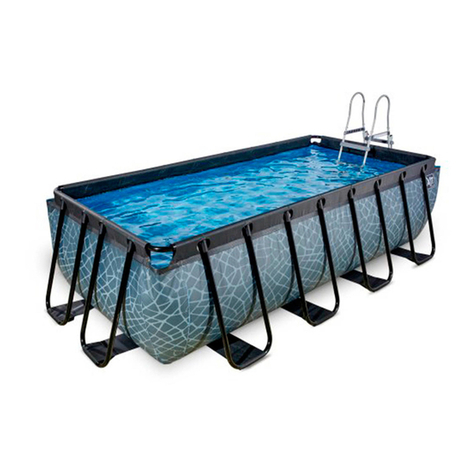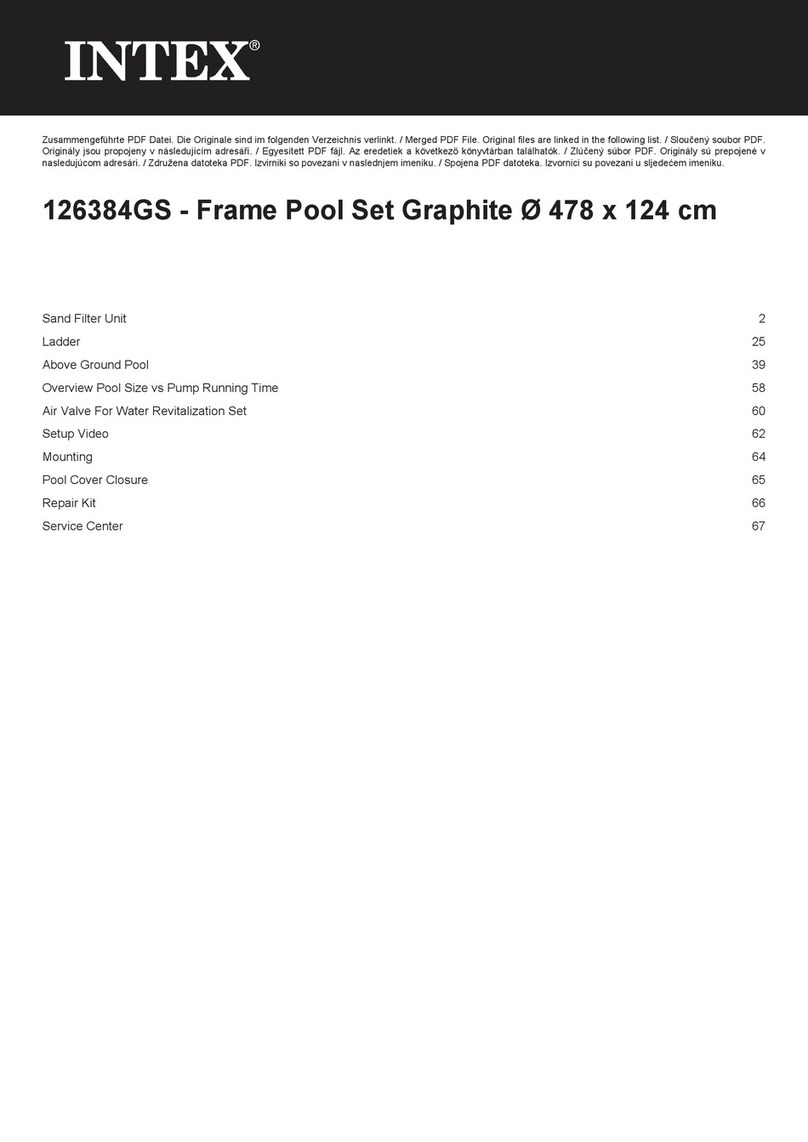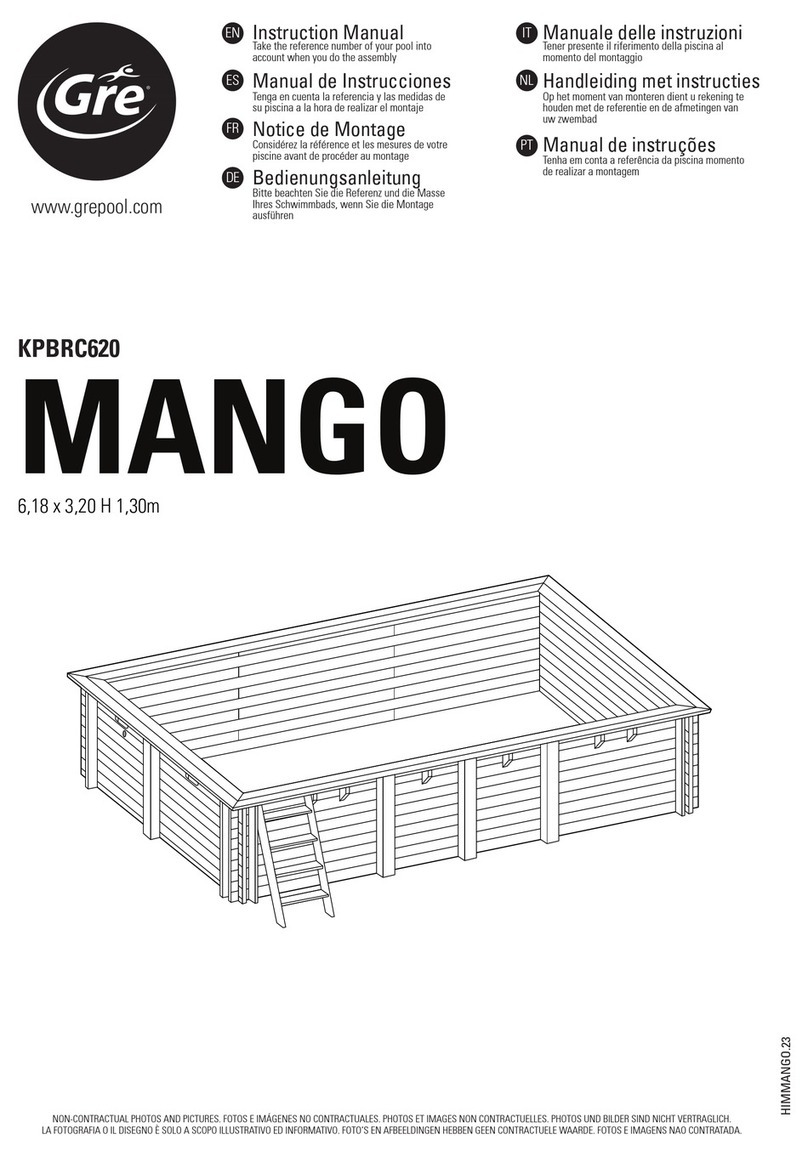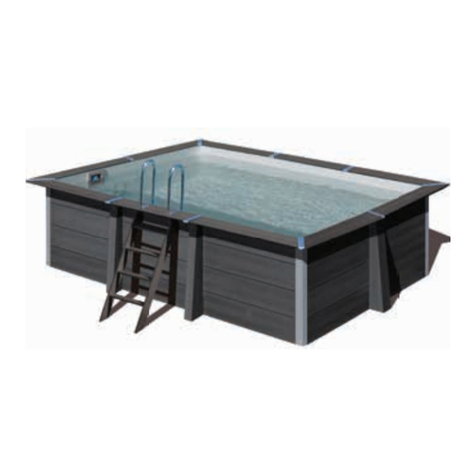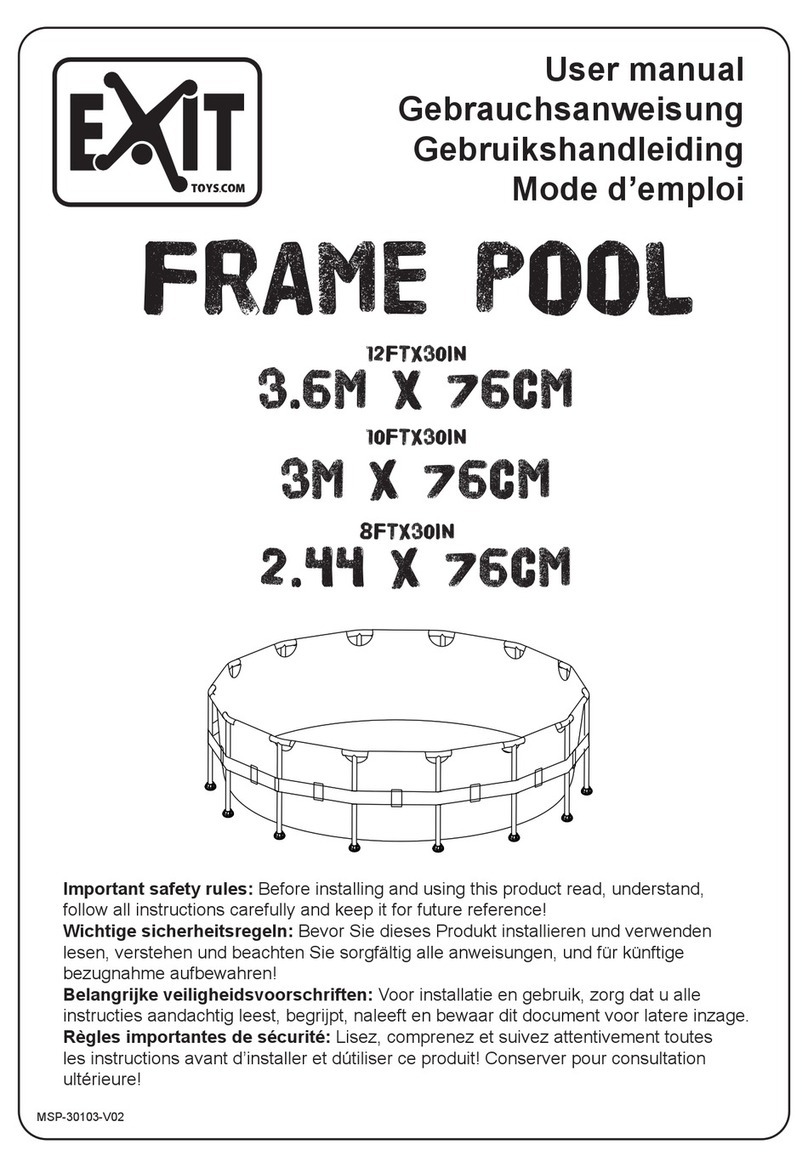habitat et jardin Tobago User manual

Tobago
1298_89171

NO. Image Description Description (French) QTY. Dimension
1
2
3
4
5
6
7
8
9
10 BRACKET tube crochet 2
11
12
13
14
15
16
17
18
19
20
21
22
23
24
25
26
27
28
Pool Wall
mur 1
PVC liner liner PVC 1
Rail rail 28
Rail
Connector connecteur rail 56
M6*11 BOLT boulon M6*11 20
M6 NUT écrou M6 20
M6 WASHER rondelle M6 20
SCREW CAP capuchon 20
SKIMMER écumoir 1
STUDDLE tube long 2
FOOT BAR tube court 2
HANDRIAL poignée supérieure 2
TREAD marche 4
PLUG bouchon 4
BASE base 1
PLATFORM plateforme 1
LOCK fermeture 2
FIXER fixation 2
SUPPORTER embout protecteur 2
SOFT PROTECT pare-chocs 2
M6*45 BOLT boulon M6*45 12
M6 LOCK NUT écrou fixeur M6 10
M6*30 BOLT boulon M6*30 4
M6 CAP NUT écrou capûchon M6 4
M6 WAHER rondelle M6 4
M6 NUT écrou M6 6
M6*40 BOLT boulon M6*40 4
φ3.5*0.9m
φ3.5*0.9m
R1750*800mm
φ12*80mm
φ6*11mm
φ11.5*5 mm
φ12*φ6.5*1.4
mm
φ14*18.5mm
φ160*380 mm
φ25*980 mm
φ25*787 mm
25*415*560 mm
415*68*50 mm
φ25*10.4 mm
535*126*45 mm
350*380*40 mm
30*60*70 mm
48*62*65 mm
φ25*25 mm
φ40*60 mm
φ6*45 mm
φ11.5*6 mm
φ6*30 mm
φ11.5*10 mm
φ12*φ6.5*1.4
mm
φ11.5*5 mm
φ6*40 mm
POOL SAFETY LADDER
25*180*988
mm

EN
Introduction:
We are pleased that you have chosen to buy a poolset from our product
range. Please devote a few minutes of your time to read this assembly
manual before you begin to install the pool. By doing so you will get
information necessary in order to extend the life of the pool and to guaran-
tee safety and bathing pleasure.
For the installation at least 2 people are required, naturally, it can be done
quicker if somebody else helps. The time for assembly, without preparation
of the ground and filling is ca. 3 hrs.
For the assembly, additional tools and materials are required (not included
in the set):
● screwdriver
● insulating tape
● long wooden board (straight!)
● tape measure
● hacksaw
● safety gloves
● spirit level
● swimming pool fleece
Important information:
Read and adhere to all instructions before putting the product into opera-
tion!
Continuous and competent supervision of children and handicapped
persons by adults is important.
Take safety precautions to prevent unwanted use of the pool.
Take safety precautions to protect children and pets.
Pool and pool accessories should only be put up and dismantled by
adults.
Never jump into the pool and do not swim underwater.
To ensure a safe installation, place the pool on safe, firm ground.
Otherwise, it can happen that the pool collapses and anybody in the pool
can be “washed out” and injured.
Do not allow anybody to sit on the side of the pool or to climb up.
Please remove all water toys in and around the pool when the pool is not
in use, since such toys attract small children.
Remove chairs, tables, or other climbing aids for children, from the pool.
Make sure that the safety equipment is close to the pool and that the
emergency telephone numbers are placed next to the closest telephone.
Examples of rescuing equipment:
Ring buoy, approved by the coastguards, with a rescue pole with a
minimum length of at least 366 cm.
Keep your pool clean and pure. The bottom of the pool must always be
visible from the outside.
If you use your pool at night, make sure that all warning signs, the ladder,
the bottom of the pool and the environment are lit up sufficiently.
Never use the pool under the influence of alcohol or drugs!
Warning! Keep children away from the covered pool to prevent them
getting tangled up in the cover sheet and drowning or being seriously
injured.
The cover sheet must be completely removed before using the pool.
Make sure there are no children or adults under the sheet, since they
cannot be seen.
Please do not cover the pool when it is in use.
Keep the area around the pool clean in order to prevent injuries caused
by slipping or falling down.
Keep the water clean, this protects all users of the pool from illnesses.
The pool is an object of everyday use. Pay attention to the correct
maintenance of your pool. Often, an excessive or fast deterioration of the
water quality can damage the pool.
This pool is suitable for use outside.
In order to ensure that the water is circulated at least once a day, it is
recommended to also switch on the filter pump during the use of the
swimming pool. Refer to the operating manual for exact instruction on
calculating the operating hours required for the filter pump.
The pool should always be filled with water. If the pool is to be completely
emptied, then you must make sure that the steel wall is secured, since
this will otherwise fall over.
SAFETY BARRIERS OR POOL COVERS CANNOT REPLACE THE
CONTINUOUS AND COMPETENT SUPERVISION BY ADULTS.
ADULTS HAVE TO ASSUME THE FUNCTION OF A LIFEGUARD AND
TO TAKE CARE OF THE SAFETY OF THE SWIMMERS, ESPECIALLY
THAT OF CHILDREN IN AND NEAR THE POOL.
FAILING TO OBSERVE THESE SAFETY INSTRUCTIONS CAN CAUSE
DAMAGE TO OBJECTS, SERIOUS INJURIES AND EVEN DEATH!
Important safety regulations:
Read and adhere to all instructions before putting the product into opera-
tion! These warnings, instructions and safety regulation deal with some
of the general hazards when relaxing in water, but they cannot cover all
risks and hazards in all events. Take care, common sense and the
correct judgement during swimming are important. This manual must be
kept for reference purposes later.
General
● Inspect all pins, bolts and screws regularly for rust, in order to avoid
injuries, check whether there are any splinters or sharp edges
(especially on surfaces that are touched).
Safety of non-swimmers
● The uninterrupted, active and careful supervision of inexperienced
swimmers and non-swimmers by a competent adult is continuously
required (taking into consideration that the danger of drowning is
greatest for children under five).
● Nominate an adult who supervises the pool every time it is used.
● Inexperienced and non-swimmers should wear personal protective
equipment when they use the pool.
Safety precautions
● The installation of a barrier is recommended (if possible - secure all
doors and windows) to prevent unauthorised access to the swimming
pool.
● Barriers, pool covers, pool alarm and similar safety equipment are
good aids and appliances are, however, not a substitute for
uninterrupted competent supervision by an adult.
Safety equipment
● It is recommended to store rescue equipment (e.g. lifebelt) close to the
pool.
Safe use of the pool
● Encourage all users - especially children - to learn to swim.
● Learn the life saving measures (resuscitation) and refresh this
knowledge on a regular basis. In an emergency this can make a
life-saving difference.
● Instruct all pool users, including children, on what is to be done in
emergencies.
● Never plunge into shallow water. This can lead to serious injuries or
death.
● Do not use the pool if you have drunk alcohol or taken medication; this
can impair your capability to use the pool safely.
● If a pool cover is used, remove this completely from the water surface
before climbing into the pool.
To protect you from unnecessary surprises, it makes sense that you
make a plan before setting up the pool on what material you need and
what you want to do in a time schedule.
Do not install the swimming pool on a windy day. It is extremely diffi- cult
to keep the swimming pool wall upright and it would probably fall,
resulting in injuries. Mount the pool liner on a warm, sunny day, so it is
easy to interpret in the pool. You shouldn’t also mount the swimming pool
liner in direct sunlight, since the thermal expansion not an optimal fit of
the film is given. The best time for the installation of the swimming pool
liner is in summer, early morning or late even- ing. Do not mount the pool
liner at temperatures below 20°C, other- wise the film is stiff and difficult
to assemble.
The swimming pool filter system and other accessories may be op-
●
●
●
●
●
●
●
●
●
●
●
●
●
●
●
●
●
●
●
●
●
●
●
i
i

i
i
EN
erated electrically. If you do not have appropriate electrical connec- tions in
your garden, it is necessary to establish this.
The necessary electrical connections must be made by a licensed electrical
contractor. The supply lines are secure and in addition to earth with a
residual current circuit breaker 30 milliamps. The rele- vant statutory
provisions as ÖVE, VDE etc. must be observed.
Avoid sharp objects in the pool. This could lead to damage to the film. Do
not climb onto the handrail. This could result in damage to the handrail or
the pelvic wall.
Swimming pools with a depth of 90 or 120 cm are not suitable for dives or
headjumps. Failure to comply could result in severe head or spinal injuries!
Never leave your children unattended when they are in or around the
swimming pool!
Should there be children in your home or neighborhood, who can not swim,
we recommend you to set up an inexpensive mesh fence which is available
in construction stores, around your pool. Tarpau- lins or other pool covers
do not provide child safety. So do not leave that pool covers, no matter what
kind they are, get rid of the respon- sibility for your children.
When choosing a location for your pool, you should take considera- tion of
several factors.
Under no circumstances, the swimming pool must be installed below
ground level. This swimming pool must only be installed above ground and
on a hard, solid ground. Your pool should therefore not be bolted on banked
surfaces. This could lead to subsidence and thus damage to the swimming
pool. If it is possible choose the sun- niest spot in your garden. The larger
the area of the basin, the better it is. At least you should have an open
space of about 90 cm around the pool.
If there is the possibility of a sheltered spot, so you should choose for your
pool. A swimming pool which is unprotected from the wind is subject to a
high heat loss by convection and evaporation. You shouldn’t place your
pool next to or under trees, bushes, etc. (large maintenance effort).
Under no circumstances your pool should be installed under over- head
lines. Avoid providing your pool on land lines.
We want you to have your pool for many years with great pleasure. The
effort and care that you put into the preparation of the founda- tions can
make a great difference in the life span of your swimming pool and its liner.
The better prepared and fixed the place is, the longer you will have to enjoy
your swimming pool. Therfore we apply appropriate care. It is absolutely
necessary that the ground on which your pool is built is flat and stable (no
banked areas).
Settlements would inevitably lead to deformity and damage to your pool.
Remove roots, grass and stones in the selected area, including those
under the ground. The weight of the water will compress these elements
between the liner and the earth under the swimming pool, resulting in
damages. Grass left underneath the pool liner will rot and give of an
unpleasant odor and stones and roots will damage the pool liner.
If you build your pool directly on concrete, asphalt or a similar sur- face, so
it is essential that between the substrate and the film a commercial mineral
fiber fabric is introduced as a separating layer. Never install this swimming
pool inside a garage, or on a balcony, roof, terrace or any other surface that
is not completely flat and solid. The maximum weight that the installation
site can support must be taken into consideration.
The basin is generally not suitable for installation in the ground, there is no
guarantee at contravene.
Please refer to the dimensions according to the table and draw on your
installation location with lime powder or spray paint.
1.Hammer a peg into the ground in the center of the area where you want
your pool.
2.Now drag a circle with a cord and a can of paint or spray with lime
powder, with the radius of which is specified in the table.
R+ is the radius of the required footprint. (Figure 2, 4)
3.Level the ground in the marked area. The entire area of the swimming
pool must be leveled and free of stones and twigs. (Figure 5)
Using a leveling tool, a straight wooden board or even better would be a
yardstick (alu slat) and level the surface down to the level of the lowest
point. Do not fill in the holes; dig away higher areas. Scatter a fine layer
of sifted sand over the levelled surface and level again. Dig from the
raised spots. In no case the subscript throw up, this could lead to
subsidence.
Figure 6, 7
Now pave the installation location so until this is completely flat. Only a
properly prepared installation site is a prerequisite for a functional pool.
Using floor insulation:
If you isolate the pelvic floor with Styrofoam or Styrodur, it is neces- sary
to make the whole pool to the insulation.
Bring to a maximum of 3 cm thick, flat gravel layer and compress them.
Then place the insulation into the bottom gravel bed.
Figure 9
1) Floor insulation treadable
2) Gravel bed max. 3 cm
3) Excavation turf
Figure 10
4) Excavation
5) gravel bed
6) floor insulation added sheepishly
With a concrete foundation the instructions are the same, with the
concrete slab replaced the gravel bed (thickness depends on the lo- cal
conditions at 15 - 20 cm with steel reinforcement).
Place the bottom profiles around the circular area, except the last profile.
The profiles are connected with 2 joints of plastic. Figure 11.12
Unpack the coiled pool wall and place it vertically on a cardboard at the
center of the pool circle. The starting end of the wall must be po- sitioned
over a base plate, and the holes for the filter hoses should be positioned
where the pump and filter will be The wall is rolled clockwise completely
over the entire length of the circle in the inner profiles. Figure 13
Our tip: You can press the floor rails onto the steel wall from the bottom.
iLocation of your pool (Figure 1)
Location of your pool (Figure 1)
Plot the place of installation
Leveling the place of installation
Installation of floor rails
Tank size R R+ detached
Ø 3,5 m 1,75 m 2,0 m

i
EN
Complete the circle, line up the holes in the two ends oft he pool wall and
join the ends with a bolt and nut through each head. The head oft he bolts
must be on the inner surface oft he wall, and the wash- ers and nuts on the
outer surface. There are two lines of holes on the wall. It is important that
each hole has a screw (except the last one), otherwise, the pool could
break when filling. Recheck all of the base plates to make sure each one
are centered where the base rails meet. Even make sure, that all lower
profiles are set correctly. Now you may cut to measure the last section with
a hacksaw. For this you only just need to lift the steel wall a little bit. Also do
not for- get the plastic connectors. Figure 14
Using a strip of PVC 2 (not included in delivery), cover the bolt heads on the
inside of the pool wall to protect the liner from rubbing against objects,
which is the main cause of tears in the liner. This tape must adhere firmly, if
it’s necessary, use PVC glue. Stick the strip with glue for PVC to insure that
for instance the screws are completely covered before moving on to the
next step. Figure 15
Make sure that the swimming pool is completely circulare.
If you use no floor insulation
Cover the inside bottom border of the circle using clean thin sifted sand free
of any stones or foreign objects with a height of 1 - 2 cm and condense this.
Press the sand into a vertical triangular shaped layer that covers the
sections and the inside part of the metal wall. The height of this triangular
layer must be around 7 cm. In this way, you will prevent the liner from
sliding under the metal wall and being damaged due to the pressure and
the weight of the water. To prevent the sand from escaping you should fit an
additional plastic foil along the pool floor.
Figure 17 & 18
1) chamfer
2) tape
3) platic film
4) steel jacket
Here you can use our optional Styrofoam wedges. These are glued with an
adhesive force on the round floor insulation along the pool wall.
Alternatively you can, however, make a furrow of sand, as described
above.
Independent of which of the two possibilities you choose, you have to apply
to the floor insulation and the fillet a swimming fleece because otherwise
the bottom of the pool liner insulation deprives the plasticizers, the film
becomes brittle and thus significantly reduces the lifetime. In addition, if
using the variant with sand, the inner foil is protected.
The liner used has been developed to withstand exposure to heat and
ultraviolet rays for a long period of time. Therefore, under certain climates
and conditions of use, the liner quality can vary slightly.
Never walk on the liner with shoes on!
The liner is the most important and delicate part of the swimming pool. Do
not use knives or any sharp objects to open the swimming pool
bag/container. Carefully separate the liner from the rest of the parts and
keep it in a safe place to avoid undesired holes or damag- es that could be
caused by the tools or the metal wall.
Install the liner on a sunny day, minimum 20º C, so that it can easily stretch
during the installation. It is made of a highly flexible vinyl ma- terial.
1.Place the liner (L) in the center of the swimming pool and unfold it
towards the sides. Place the rough side towards the inside of the pool. The
pool foil must be perfectly butted to the furrow and the wall. Figure 19
2.Lift the foil over the edge of the swimming pool and secure it using
clothes pegs, Remove the excess folds by lightly pulling the foil outwards
to adjust it. Pull the foil carefully, avoid too much tension. Figure 20
3.It is very important, that the liner is centered, well extended and not
wrinkled. Start filling the pool with water, but not more than 2-3 cm and
work out all the wrinkles and smooth the liner to the wall. Dont’t strech the
liner too much.
4.Insert the U-profiles around the edges of the pool now. After the U-
profiles are installed, cut the last profile to the appropriate length. Figure
22.
The profiles are connected using 2 plastic connectors, as with the floor
rails. Figure 11, 12.
5.After this the pool can be filled with water up to 10 cm below the rim and
install the mountable cartridge filter system.
At the end oft he swimming season, the pool should be removed and
stored dry. This also applies to the filter system. Damage caused by
freezing isn’t covered by warranty!
End of season
If you use floor insulation
Installation of floor rails
This manual suits for next models
2
Table of contents
Languages:
